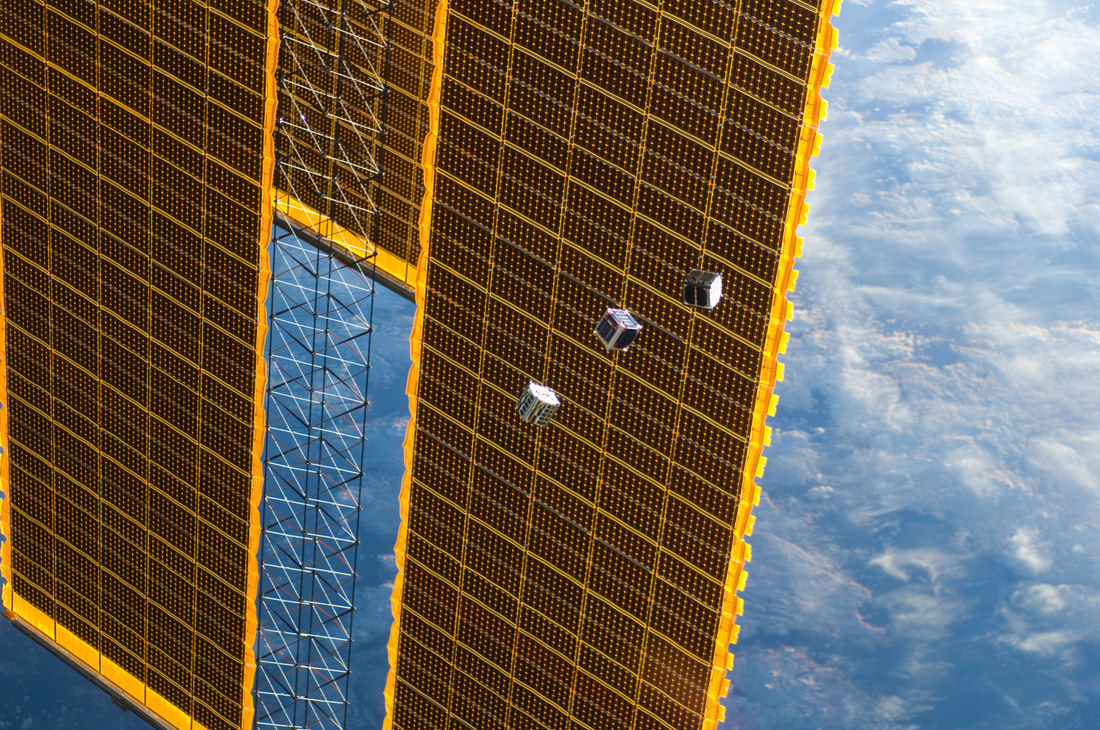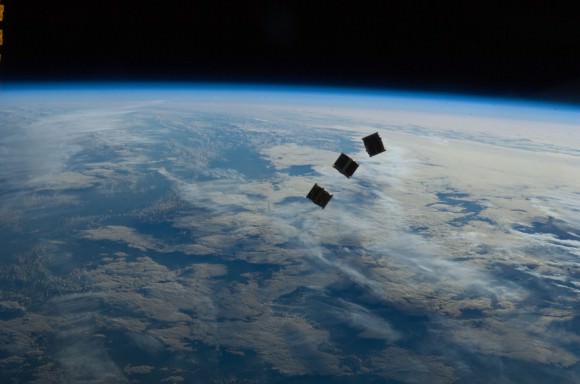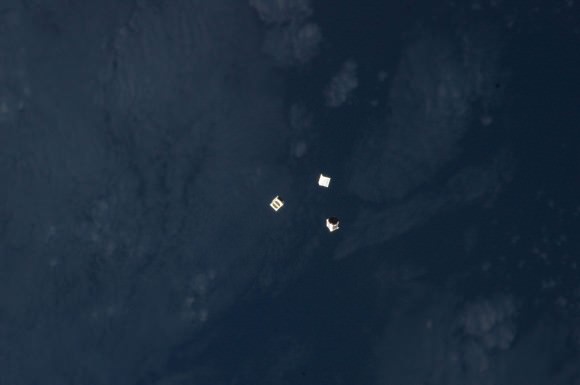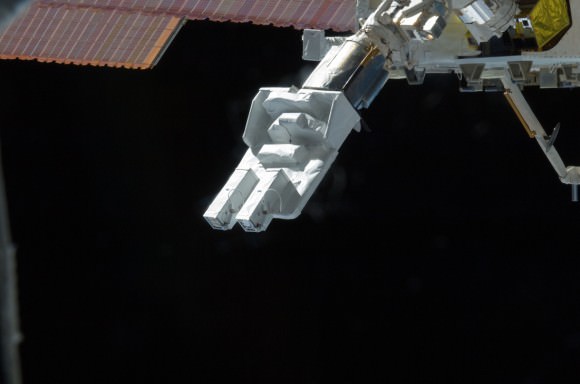Three small CubeSats are deployed from the International Space Station on October 4, 2012. Credit: NASA
Five tiny CubeSats were deployed from the International Space Station on Thursday and astronaut Chris Hadfield called the image above “surreal” on Twitter. And rightly so, as they look like a cross between Star Wars training droids and mini Borg Cubes from Star Trek. The Cubesats measure about 10 centimeters (4 inches) on a side and each will conduct a range of scientific missions, ranging from Earth observation and photography to technology demonstrations to sending LED pulses in Morse Code (which should be visible from Earth) to test out a potential type of optical communication system.
These are low-cost satellites that could be the wave of the future to enable students and smaller companies to send equipment into space. If you’re worried about these tiny sats creating more space junk, Hadfield assured that since they are very light and in such a low orbit, the Cubesat orbits will decay within a few months.
The Rubic-cube-sized Cubesats were deployed from the new Japanese Small Satellite Orbital Deployer that was brought to the space station in July by the Japanese HTV cargo carrier.
The Japanese FITSAT-1 will investigate the potential for new kinds of optical communication by transmitting text information to the ground via pulses of light set to Morse code. The message was originally intended to be seen just in Japan, but people around the world have asked for the satellite to communicate when it overflies them, said Takushi Tanaka, professor at The Fukuoka Institute of Technology.
Observers, ideally with binoculars, will be able to see flashes of light — green in the northern hemisphere, where people will see the “front” of the satellite, and red in the southern hemisphere, where the “back” will be visible.
The message it will send is “Hi this is Niwaka Japan.” Niwaka is the satellite’s nickname and reflects a play on words in the local dialect of southwestern Japan, according to an article on Discovery Space. To see the Morse Code message, the Cubesat will be near the ISS, so find out when you can see the ISS from NASA or Heaven’s Above. Find out more about the FITSAT at this website.
The other Cubesats include NASA’s TechEdSat which carries a ham radio transmitter and was developed by a group of student interns from San Jose State University (SJSU) in California with mentoring and support from staff at NASA’s Ames Research Center.
“TechEdSat will evaluate plug-and-play technologies, like avionics designed by commercial providers, and will allow a group of very talented aerospace engineering students from San Jose State University to experience a spaceflight project from formulation through decommission of a small spacecraft,” said Ames Director S. Pete Worden.
The other Cubesats include RAIKO, which will do photography from space, We Wish, an infrared camera for environmental studies, and and the F-1 Vietnam Student CubeSat which has an on-board camera for Earth observation.
See more cool-looking images and video of the deployement below (all images credit the Expedition 32 crew from the ISS/NASA):





I wonder if SpaceWeather or Heavens-Above will start tracking them. I would love to observe the Morse Code.
Just use it to track the ISS. The cubesats will have the same orbits as the ISS until their orbits decay. The orbital elements, aka “Keplarian Elements” for the cubesats will be published soon. At that point their individual identities will appear in Heavens-Above.
Or… you can download a free satellite tracking program such as Orbitron, from here… http://www.stoff.pl/ and track them directly on you PC once the elements are available. There are other programs that can be used for this as well as apps for both iPhone and Android, a quick search of the net will turn up many.
I’m on the Equator … what colour will the LED’s look to me? 🙂
On a more serious note, the ISS is scheduled to make a pass over my house on the 9th of Oct. Will the LED’s be working until then?
Am I the only one wondering if this is how the Borg got started?
I’m taking issue with two statements in this article:
“The Cubesats measure about 10 centimeters (4 inches) on a side…”
No! They measure EXACTLY 10 cm on each side- it is a fundamental part of their specification.
Unnecessary vagueness in scientific reporting is unacceptable.
“These are low-cost satellites that could be the wave of the future to enable students and smaller companies to send equipment into space.”
No, they already are the wave of the RIGHT NOW – about 80 have been launched since the first in 2003.
Don’t believe a word of it! It was Aliens in mini ships attacking all INSECTS on our Planet